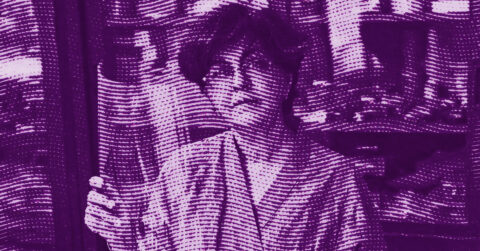Listen to me carefully, you bunch of snobs, while I tell you about Wynnie Mynerva, born in 1992 in Villa El Salvador, on the outskirts of Lima. If you think you’ve seen it all in contemporary art, think again. Here is an artist who does not just paint pretty pictures to decorate your sanitized living rooms.
While transgression has become just another commodity, Mynerva achieves the feat of truly shaking us. Not with gratuitous provocations, but with a visceral approach rooted in her personal experience, in the systemic violences she has suffered, in her revolt against gender norms and patriarchal structures. As Simone de Beauvoir wrote in The Second Sex, “one is not born, but rather becomes, a woman,” well, Mynerva goes further by demonstrating that this social construct can also be undone, shattered into a thousand pieces on her monumental canvases.
Take her exhibition “The Original Riot” at the New Museum in 2023. A mural over 21 meters long, the largest ever shown in this institution, rewriting the biblical myth of Eve and Lilith. But beware, this is not a simple feminist reinterpretation to please gender theorists. No, Mynerva pushes performance to the extent of having one of her ribs surgically removed, the one called “Adam’s rib”, to incorporate it into the artwork. This gives new meaning to the expression “putting one’s body at the service of art.” Susan Sontag warned us in “Against Interpretation” that art must be a sensory experience before being an intellectual exercise. Mynerva understood this well, making her body both the subject and the medium of her work.
The first characteristic of her work lies in her unique way of approaching corporeality. Her paintings do not simply depict bodies; they are bodies. Masses of flesh overflowing the frame, organs that seem to pulse on the canvas, limbs intertwining until they form new creatures. It’s Francis Bacon meeting Ovid’s Metamorphoses, but with an explosive political dimension. Judith Butler, in Bodies That Matter, theorized the performativity of gender. Mynerva goes further by creating a pictorial performativity where the canvas itself becomes a body in transition, a space of perpetual metamorphosis.
At the Fondazione Memmo in Rome, in 2024, she offers us a heartbreaking meditation on chronic illness with “Presagio.” The four monumental ceiling paintings, “Cassiopeia,” “Andromeda,” “Hydra,” and “Berenice,” each measuring 330 by 340 centimeters, transcend individual suffering to reach a cosmic dimension. By appropriating the ancient concept of melothesia, which links body parts and constellations, she transforms her vulnerability into creative strength. This is precisely what Georges Canguilhem discussed in The Normal and the Pathological when he stated that illness is not simply a deviation from the norm, but another way of being in the world.
The second characteristic of her work is her ability to subvert the codes of classical painting while mastering them perfectly. Trained at the National Autonomous School of Fine Arts of Peru, she knows her old masters inside out. But instead of blindly revering them, she cannibalizes, digests, and transforms them. Her series “Violated Bliss” (2022) dialogues with Rubens’ “Massacre of the Innocents” while overturning its patriarchal perspective. The bodies she paints are no longer passive objects of the male gaze, as Laura Mulvey so well analyzed in Visual Pleasure and Narrative Cinema. No, they are active, desiring, sometimes violent subjects.
In her exhibition “My Weaponised Body” at the Gathering gallery in London in 2024, Mynerva pushes this reflection on the body as a site of political resistance even further. Following her HIV diagnosis, she transforms what could be experienced as stigmatization into a powerful assertion of self. These new works on raw, unstretched canvas, sometimes densely populated with organic forms, sometimes left almost virgin, evoke flayed skin. Our bodies carry the marks of the joys and sufferings we have experienced, the struggles we have fought. Mynerva makes this bodily inscription the very engine of her creation.
The way she handles the pictorial material is revolutionary. The pigments seem to bleed on the canvas, creating areas of variable density that evoke organic tissues seen under a microscope. In “Transmutacion” (2024), violet and brown brushstrokes build a muscular calf or a supple belly before decomposing into shapeless masses of tin gray. This is reminiscent of Julia Kristeva’s theories on the abject, but Mynerva goes beyond mere provocation to create a new visual grammar of the sick body.
The sculptural installation “Hueso” (2024), a spine made of resin, fiberglass, and polyurethane that snakes over two floors of the gallery, dialogues with the canvases like a skeleton with its flesh. This work echoes Michel Foucault’s reflections on the body as a site of power inscription, but also as a potential site of resistance. For Mynerva, the HIV-positive body is not a defeated body, but a body that refuses to submit to social injunctions of shame and silence.
Her references to Lilith, Adam’s first woman banished from the Garden of Eden for refusing sexual submission, take on a new dimension here. In the Abrahamic tradition, Lilith is demonized, sexualized, fetishized, exactly like bodies today that do not conform to heterosexual norms. But Mynerva makes her a symbol of resistance, a tutelary figure for all marginalized bodies.
What is fascinating about Mynerva is that she maintains a precarious balance in her works between beauty and violence, between seduction and repulsion. Her works are magnificent while being deeply disturbing. She perfectly masters what Roland Barthes called the “punctum,” that detail which disturbs the “studium,” the calm reading of the image. A black lacquered fingernail springing from a mass of flesh, a pair of bloodied kidneys emerging from a gray background, a headless torso with perfect breasts, so many elements that pierce our comfortable perception.
The power of her work also lies in her ability to transcend traditional dichotomies: inside/outside, male/female, healthy/sick. As Donna Haraway writes, whom she often cites, viruses, by infiltrating and replicating within cells, erase the clear distinction between the “internal” organism and the “external” agent. Mynerva does the same with her painting, creating works that are both surfaces and depths, skins and viscera.
Her work with glass at the Fondazione Memmo is particularly revealing of this approach. The “Tesoros” sculptures, created in collaboration with a Venetian master glassmaker, use breath as a medium, a subtle reminder of the divine act of breath giving life in Genesis. But here, this breath creates ambiguous forms, neither quite organic nor quite artificial, which challenge our usual categories of perception.
There is something deeply revolutionary in the way Mynerva approaches chronic illness. Instead of seeing it as a pathogenic invasion to be fought, she considers it as a complex ecosystem with which one must learn to coexist. This approach echoes the works of Paul B. Preciado on pharmacopornography, but Mynerva goes further by creating a true aesthetic of cohabitation with the virus.
Superficial critics will say that her work is too literal, too bodily, too political. But this is exactly where her strength lies. In an often disembodied art world, Mynerva reminds us that our bodies are political battlegrounds, sites of resistance and transformation. As Audre Lorde wrote, “our silences will not protect us.” Mynerva breaks these silences with an explosive force.
Her use of scale is particularly noteworthy. When she paints these massive canvases that occupy entire rooms, she is not just trying to impress. She creates immersive environments that force the viewer to physically confront the work. This is what Maurice Merleau-Ponty called the “flesh of the world,” this fundamental interconnection between the perceiving body and the perceived world.
I see in Mynerva’s work the emergence of a new form of body art that transcends traditional gender boundaries. She is not simply an artist who paints bodies or uses her body as a medium. She creates a new visual language that accounts for the bodily experience in all its political and existential complexity. This is exactly what contemporary art needs: less postmodern cynicism, more flesh, blood, and conviction.
So yes, you can continue to marvel at your small, neat canvases that disturb no one. But know that meanwhile, Wynnie Mynerva is reinventing painting, pushing the boundaries of what art can say and do. And she does so with an urgency and authenticity that are sorely lacking in the contemporary art world.
















